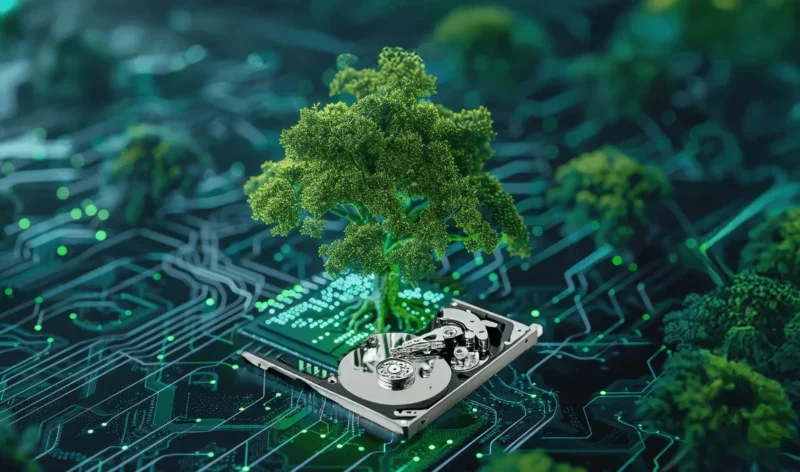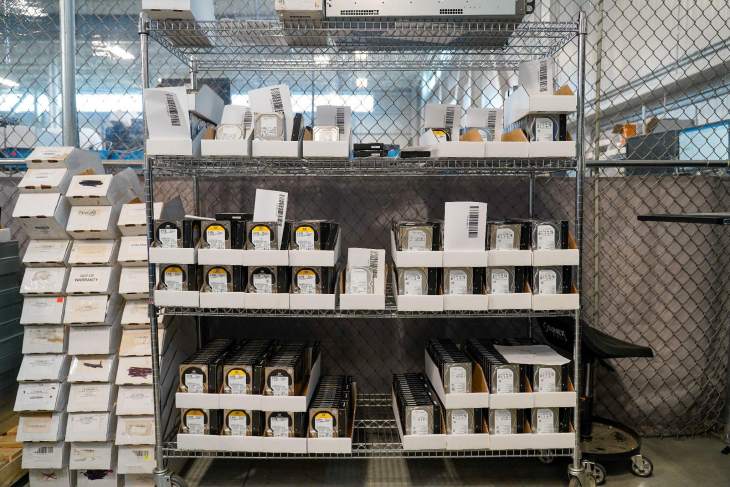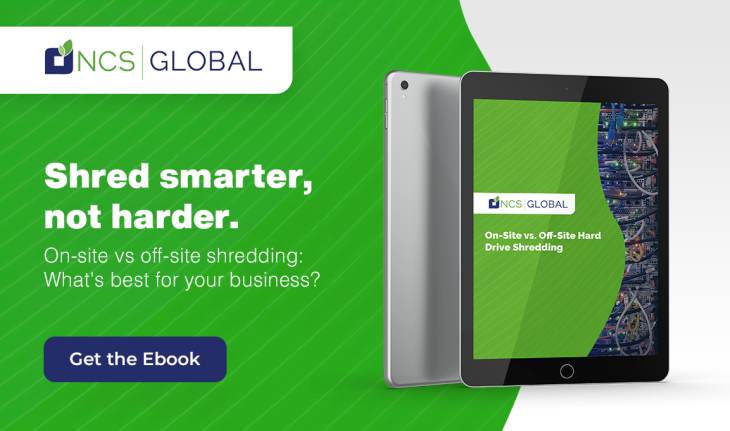The Environmental Benefits of Hard Drive Shredding

New technology is emerging at a faster pace than ever before. That includes printers, mobile devices, servers, laptops, and more. As replacement cycles get shorter and digital technologies grow more pervasive, the world is generating record volumes of electronic waste, also known as “e-waste.”
Simply sending all these legacy devices to the landfill is not an option. Many of them contain sensitive and confidential data, including personally identifiable customer information, valuable trade secrets, and detailed financial records. If bad actors can manage to get their hands on these items before they reach the landfill, they could use that information to compromise corporate networks, collect private information, or steal important trade secrets. Best practices dictate that companies destroy the data contained on hard drives and other storage media. In many cases, the law requires it as well.
How can companies dispose of legacy assets and destroy sensitive information responsibly, without negatively impacting the environment? Best practices in IT asset disposition (ITAD) offer a methodology for protecting valuable corporate and customer data while also protecting our precious ecosystem.
The Problem with E-Waste
The UN’s Global E-Waste Monitor initiative estimates that global e-waste will reach nearly 75 metric tons by the year 2030. That’s twice the amount that we produced in 2014. Moreover, the devices we rely on to process digital information often contain small quantities of toxic substances. Collectively, that creates a potentially enormous problem: if we don’t dispose of those devices responsibly, we run the risk of contaminating our groundwater and soil.
E-waste typically contains valuable materials like copper, gold, and iron, as well as hazardous substances such as lead and mercury. The latter can pose significant environmental and health risks if not properly managed. According to the Global E-Waste Statistics Partnership, the total economic value of metals in the e-waste generated globally in 2022 was estimated at USD $91 billion, yet a large portion of these materials remains unused because companies fail to recycle them.
Hard drives present some specific challenges when it comes to e-waste. They often contain sensitive, confidential, or personal information, so it’s critical that companies see to the security of the data they contain.
Hard drives also contain hazardous materials, including lead and potentially toxic rare earth metals. They also contain valuable materials like aluminum and gold, yet recovery of these materials is usually only marginally cost-effective. Fortunately, ITAD service providers are discovering better ways to get the job done. That means more recycling, less waste, and safer handling of materials.
How Hard Drive Shredding Helps the Environment
Hard drive shredding ensures that sensitive data is completely unrecoverable, so it’s one of the best ways to address the security challenges associated with IT asset disposition. It’s also good for the environment because it reduces hazardous waste and prevents toxic substances from leaching into our soil and groundwater.
By recapturing valuable materials from shredded hard drives, ITAD service providers help to reduce our need to extract those raw materials from the earth in the future. Recycling also lowers energy consumption because it is inherently more efficient than the processes of mining and refining new raw materials.
The Process of Eco-Friendly Hard Drive Shredding
Here’s how eco-friendly hard drive shredding works:
- Shredding: ITAD service providers use specially made industrial shredders to break hard drives down into small pieces. This step is critical for data destruction because it ensures that any remaining data on the drives is irretrievable. It also facilitates recycling, however, by allowing for the further separation of materials.
- Separation of Materials: Next, the resulting debris is separated into distinct groups such as metals, plastics, and circuit board materials. There are several different techniques used to achieve this, including magnetic separation, which removes ferrous metals, and eddy current separation, which extracts non-ferrous metals.
- Material Recovery: Shredded metal is further separated into its distinct parts. Valuable materials such as aluminum, copper, gold, and platinum can often be recovered from shredded drives. These metals can then be recycled and reused to manufacture new products.
- Safe Disposal of Toxics: Finally, ITAD service providers separate and process any hazardous materials in accordance with applicable environmental safety standards.

Best Practices for Sustainable Hard Drive Disposal
Proper disposition of hard drives and other storage media should be part of your company’s overall IT lifecycle management strategy. Working with a top ITAD service provider helps you to comply with all relevant environmental and cybersecurity regulations and standards, as well as to maximize your company’s bottom line.
As you look for the right ITAD services partner, pay particular attention to widely recognized industry certifications, including those that focus on sustainability. E-Stewards and Ecovadis are among the most respected certifying bodies. Also look for a long-term commitment to sustainability, often signified by memberships in top organizations like the US Green Building Council.
Above all, look for an ITAD service provider that doesn’t just “talk the talk,” but proves its commitment to environmental sustainability through its actions.
The best ITAD companies can work with you to develop an IT asset lifecycle management policy that incorporates sustainability and responsible e-waste management practices. As part of that initiative, companies should work proactively to raise awareness among employees and other stakeholders about the importance of e-waste recycling.
Conclusion
Proper hard drive shredding and recycling contributes to a more sustainable world by lessening the need for landfill space, preventing toxic materials from polluting our environment, and reclaiming raw materials. The entire process ensures absolute data security while improving our environmental impact and reducing energy consumption.
Regulators and consumers alike are paying closer attention to environmental impact than ever before. Corporate leaders around the world are responding positively by adopting best practices in IT lifecycle management, including sustainable IT asset disposition processes like hard drive shredding. The ITAD industry is serving a critical need in this value chain by systematically managing the decommissioning of computers and hard drives, printers, and other devices.
At NCS Global, we provide world-class ITAD services to clients around the world, with dedicated representatives for each customer, tailored services to address their unique needs, and service levels that are unmatched in the industry. Want to learn more? Contact us today to learn how we can help you.
